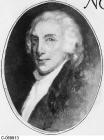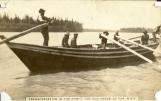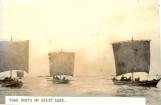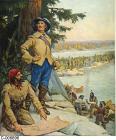14
The Hudson's Bay CompanyThe Hudsons's Bay Company (HBC) was formed when two coureurs de bois defected from the French Fur trade in New France to London to entice King Charles II to form a company that would exploit the rich fur resources in the Hudson Bay region of North America. On May 2, 1670, Charles II of England authorized a Royal Charter that created "The Governor and Company of Adventurers of England trading into Hudson's Bay". The King placed his cousin Prince Rupert in charge of this endeavor, and granted the company trading rights to "Rupert's Land" - all the lands drained by rivers flowing into Hudson Bay - an immense area that covered almost half the continent.
16
The North West CompanyMade up of both French and English traders, this company was headquartered in Montreal and was the single biggest competitor to the HBC. Highland Scots dominated the company and it became one of the first truly North American enterprises. The company was headed by Simon McTavish, a Scot who arrived in North America almost penniless at age 13 but went on to build a commercial empire by the time of his death in his early 50s. In 1821 the relentless competition between the two companies ended with their amalgamation as The Hudson's Bay Company under the iron rule of the "Little Emperor", governor George Simpson.
17
Fur Trade VesselsThe First People of the northern regions of Canada used the waterways for many daily tasks. They depended on water for food, supplies for containers and decorations, and for transportation to various hunting and fishing locations.
Canoes were developed as the most practical form of water transportation for the First Peoples. They could easily navigate through the network of waterways, from big lakes to small creeks, while hauling a useful payload of cargo and passengers.
In the early days of the trade, the 'canot du nord' (North canoe) was used in the vast regions north and west of the Great Lakes. The North canoe was about 8 m. (25') long and weighed about 135 kg. (300 lb.). With a crew of four to six men, the canoe carried an average of 23 packs of trade goods or furs, plus another dozen packs of baggage and food stuffs.
19
As the fur trade became more competitive, the need arose for a larger and sturdier boat that could carry bigger loads and was strong enough to withstand the rigours of rough water and rocks.The York boat was introduced to meet these needs. Named after its most common destination - York Factory, the York boat had a double-ended hull that was modeled after an Orkney style of fishing boat, a logical development as the majority of workers recruited by the Hudson's Bay Company were from the Orkney Islands.
21
The York boat hull consisted of thick wooden planks, making the boat sturdy but heavy, and varied in length up to forty feet. Sails were sometimes used on open water, but travel was generally toilsome - especially when the voyageurs had to disembark and line the heavily laden boats through rapids, or roll the boat on logs across a portage. A York boat carried three times the freight of a canoe, but lacked the canoe's nimbleness and maneuverability in smaller waterways.The boat's voluminous capacity was ideal for freighting mountains of trade goods - but at a laborious cost to the boatmen. Manhandling the massive wooden hulls across portages involved the entire crew, and every man had to follow the instructions of the bowman [the 'avant' - leader of the boat crew] to prevent injury or loss of life, and damage to the boat and cargo.
22
York boats traveled from York Factory on Hudson Bay to The Pas, and beyond to points north and west on the Saskatchewan, Churchill, Athabasca and Peace River systems, carrying trade goods, food and supplies upriver, and bales of furs on the return trips. The use of York boats dramatically increased the number of pelts that reached the fur trade posts.The York boatmen were of strong character, with nerves of steel and legendary stamina and prowess. They came from a variety of backgrounds such as Orkneymen, Highland Scots, French Canadians, Métis, Iroquois, Cree, Chipewyan, and other Aboriginals.
24
Henry Kelsey, first European to see the North American prairies, watching buffalo on western plains.1691
unknown location
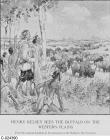
25
Henry KelseyA lad of only 19, the "Little Giant" was sent on a major inland expedition by the HBC in 1690 to scout new fur trade partners and convince native trappers to bring their furs down-river to posts on the Bay for trade. Kelsey travelled up the Saskatchewan River and over-wintered at Deering's Point. [Although the exact location of this spot is still disputed, it is generally accepted to be in the vicinity of present day The Pas.]
Kelsey's two-year expedition took him further inland than any European had been and he was the first non-Aboriginal to see the prairies and the immense herds of bison. Kelsey is believed to have travelled to the Touchwood Hills and Quill Lakes areas of Saskatchewan. He had a facility for languages and learned several Aboriginal languages from his native travelling companions.
Although Kelsey had a long career with the HBC, he was never accorded appropriate recognition for his journeys of discovery. The journal of his expedition, lost for many years, was discovered in Ireland in 1926.
27
La VerendryePierre Gaultier de La Verendrye was an explorer and fur trader from Montreal
whose primary objective was to find the fabled "great western sea" - a
shorter route to the riches of the Orient. In the late 1730s and early
1740s Verendrye and his sons explored much of the area that is now southern
Manitoba and built many trade posts at sites that eventually became cities
or towns in the province, including Fort Rouge (now Winnipeg), Fort la Reine
(now Portage la Prairie) and Fort Dauphin (now Dauphin).
Verendrye's sons Pierre and Louis-Joseph pushed further north into the
Saskatchewan River delta area by 1743, and established Fort Bourbon on Cedar
Lake and Fort Paskoyak on the Saskatchewan. Fort Paskoyak was the first
trading post built on the site that was to become the town of The Pas. The
Verendrye enterprise beat the HBC in establishing a post in the area by 30
years. Fort Paskoyak operated until the mid-1750s.
